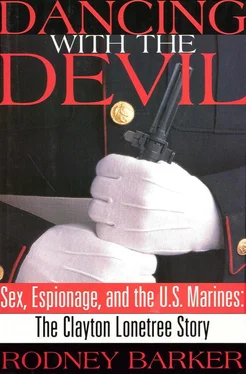Meanwhile, a post-trial agreement was executed. In it, Lonetree agreed to submit to interrogations regarding the espionage activities under oath, followed by polygraph examinations. In return for his cooperation, five years would be subtracted from his sentence, and a grant of immunity against prosecution would apply to everything he revealed. Unless, that was, incriminating information was developed independent of the briefing that indicated he had withheld information, and then he would be charged and tried in another court-martial.
At six-thirty on the morning of October 12, Lt. Col. David Breme arrived at the Quantico brig to pick up his prisoner. Coincidentally, U.S. marshals were holding an Arab terrorist in the brig at this time, and as Breme would later describe the scene, “It looked like the Israelis had been brought in to guard him. There were more goddamn Uzis around than you see in a Steven Seagal movie.”
After he was admitted to the sally port through an electronically operated door, Breme told the guard, “I’m here to pick up Lonetree.”
Five minutes later the prisoner was delivered. “They brought him down this corridor that was lined with cinderblock walls and had a concrete floor covered with linoleum, so every sound was amplified with echoes. He had ankle irons on. He had hand irons on. He had this connecting chain between them so he could only take these mincing steps. You could hear the rattle and clank of him coming and suddenly there he was, looking like Marley’s ghost, with these two apes—I mean two of the biggest brig guards I’ve ever seen—on either side of him. It was pathetic. He had a look on his face like you’d see in a dog pound. Like the faces in the pictures of the downed aviators at the Hanoi Hilton.”
As a final precaution Lonetree was frisked, and then he was turned over to Breme and two MPs, who loaded him into a white Navy Dodge van and headed for a secret location in Washington, D.C., where his debriefing was scheduled for later that morning.
Lieutenant Colonel Breme had been handpicked to be the escort officer because of his reputation as the best shot on the Quantico base. He was armed with an Austrian 9mm seventeen-shot automatic pistol, which he carried in a shoulder holster under a sports jacket worn to conceal his weapon, and two loaded magazines filled a side pocket, so in total he was equipped with fifty-one rounds of ammunition. The nature of the threat had not been specified for him, and when he had asked his superior officer what he imagined they might encounter, Breme had been told, “You never know about these goddamn supposed diplomats in Washington. Half of them are communists.”
Breme had hesitated before replying. “Sir, I’m afraid that’s not who I’m concerned about. I don’t think the KGB gives a shit about Lonetree one way or another. You know who I’m concerned about? I’m concerned about Billy Bob in a pickup truck who’s an Amurican and has a Confederate-flag license plate and who might drive by and say, ‘Goddamn, there’s that sonofabitch Lonetree,’ and open up with a shotgun. I’m more worried about a goofball like that than the Red Menace.”
By nine o’clock they were pulling up to Building 159 in the Washington Navy Yard. It was a five-story brick structure that housed a multitude of different agencies, including a branch of the Library of Congress and the Government Printing Office, but a suite of rooms on the second floor had been dedicated as the debriefing center. In one of them an eight-by-ten sound-reduction module had been assembled that was furnished with two comfortable easy chairs—one for Lonetree, one for his interrogator—and a small table-desk inset with a polygraph instrument that was covered whenever it was not in use. An exhaust fan kept the air inside fresh, and a one-way mirror provided the view for a stationary video camera mounted on a tripod. At the same time the debrief was taped, it was going to be broadcast on TV monitors to an adjacent room where chairs had been set up for an audience of thirty.
Lanny McCullah had personally selected one of his premier interrogators for the debrief, an NIS agent by the name of John Skinner (not his real name). Short, bespectacled, soft-spoken, with a low-key personality that in some ways matched Lonetree’s, Skinner was extensively trained in interview techniques. Along with an FBI agent he had debriefed John Walker. He was also one of the few NIS agents to have interviewed both KGB and GRU defectors for Soviet methodology in recruiting American military personnel.
Skinner had spent weeks preparing for the Lonetree debrief, reviewing the Lonetree case files and collecting questions from interested agencies. But perhaps most helpful to him had been a report on Lonetree put together by a CIA psychologist. After considering the biographical data accumulated on Lonetree, listening to the tapes of his confession, and reviewing the results of the mental examination ordered by the prosecution, the Agency man had logged such observations as, “Although Lonetree, in his own mind, thinks he is logical, rational and given to theorizing, he displays an unconventional thought process which is rich in fantasy, possibly bordering on the mystical, all of which he uses as an escape from an often unpleasant everyday life…. [He] sometimes experiences a distrust of his senses, not really being sure of what he sees and hears or its meaning. Sometimes, reality is blurred for him. All this said, Lonetree displays a definable moral/value system. Morally he is clear relative to the dos and don’ts of society. However he is less firm of the ‘whys’ of actions.”
Regarding his inner workings, it was written that Lonetree “projects self-doubt, low self-esteem, an amorphous identification, a lack of direction and an absence of a clear, guiding philosophy.” At the same time he was “self-centered, almost narcissistic, and prone to withdrawal and suspiciousness. In his own little world, Lonetree thinks of himself as a ‘special’ but often misunderstood person.”
Regarding the outside world, “Lonetree feels rejected and alienated…. He is sensitive to criticism, is somewhat suspicious, and distrusts people and their motives…. It is clear that one of the worst things that can happen to a person like Lonetree is to be criticized or embarrassed in public. Comments directed to Lonetree, even casual ones, if interpreted negatively, are probably never forgotten.”
The psychologist also provided insights into mannerisms and thinking patterns of Indians that could easily be misunderstood by a non-Indian in an interrogation setting. Specifically he referred to the way Indians, under questioning, tended to avoid eye contact—looking down, up, to the side—and to be mute for long periods of time before responding to a question. An investigator who didn’t know better might think that the subject was making things up, but that wasn’t necessarily true. Indians, for the most part, did not react quickly. They needed time to go through their way of thinking, which was to connect a particular to the larger scheme of things before responding. Speed them up and you’d mix them up, he said, which was what happened with Agent Brannon in London.
Finally the CIA shrink stressed the importance of establishing a rapport with Lonetree before interrogating him. He suggested that to build a bond of trust Skinner should do things like share facts about his own personal life. Engage Lonetree by openly referring to other cases he might find interesting. And since Lonetree was a reader, discuss similar tastes in books. Above all Skinner should not appear to pass judgment on anything that Lonetree said.
As it turned out, the rapport-building process took a lot more time and was far more difficult than Skinner anticipated, because when he sat down with Lonetree to get acquainted, it became immediately clear that he was dealing with a profoundly divided man. It was as if Lonetree were someone standing on a bridge with the United States on one side and the Soviet Union on the other side, and with his loyalties torn, he didn’t know whom to trust or where his safety lay. As Skinner would come to understand, this division was as much a reflection of the subversive effect his civilian attorneys had had on him as it was an indication of how deeply Clayton Lonetree had been recruited by the Soviets.
Читать дальше












